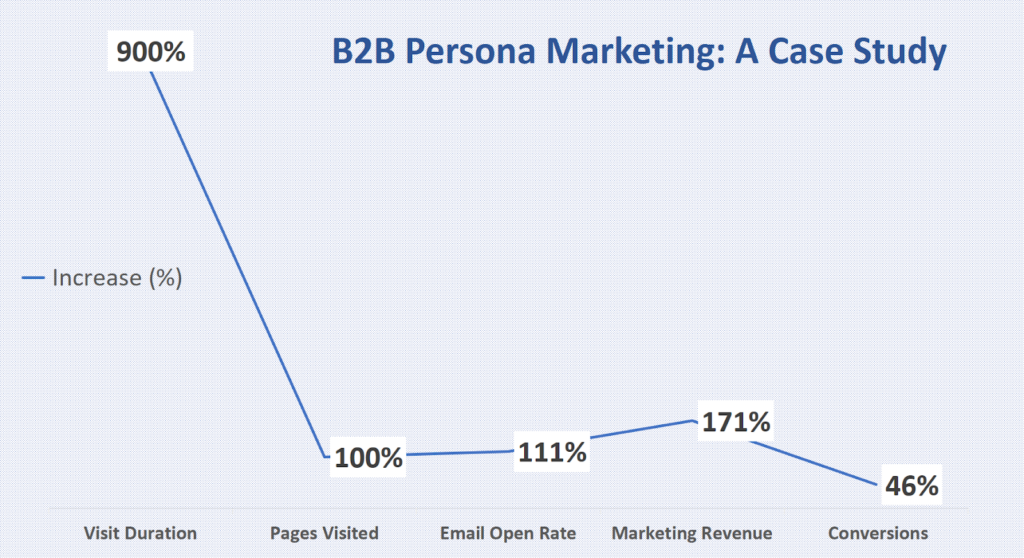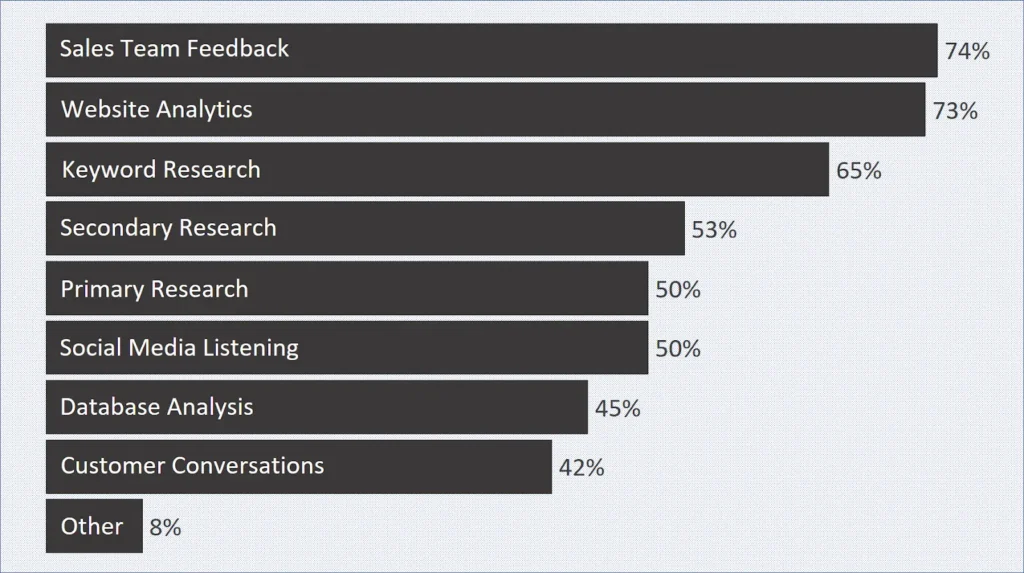Table of Contents
What Is Market Research?
Primary Vs. Secondary B2B Marketing Research
How to Use Data in B2B Market Research
The Power of Market Research Data: 10 Strategies to Improve Your Marketing Outcomes
- #1 – Refining Persona Profiles Matters in Marketing
- #2 – Understanding Customer Profiles and Buyer Personas
- #3 – Unveiling B2B Buyer Preferences
- #4 – Understanding Customer Behaviors
- #5 – Enhancing Audience Engagement with Content
- #6 – Optimize Your Keyword Strategies
- #7 – Maximizing Marketing Budgets with Data
- #8 – Evaluating B2B Marketing Effectiveness
- #9 – Navigating Industry Shifts Through Trend Analysis
- #10 – Gain a Competitive Edge with Competitive Analysis
B2B Market Research: The Power of Surveys
How to Conduct Surveys: Tools and Approaches
Focus Groups: Their Role in Successful B2B Marketing
Best Practices: Running Successful Focus Groups
When Focus Groups Are Most Useful
Unlocking Insights from One-On-One Interviews
Best Practices: Conducting One-On-One B2B Interviews
The Frequency of B2B Market Research
Maximizing the Impact of Limited Participants
Tailor Your Recruitment Strategy: Use Market Research to Attract the Best Talent
Ready to Launch Your Market Research Journey?
———————————————————————————————————————
The question that looms large among many B2B marketing teams is, why do we continue to get our strategies wrong? Usually, a campaign’s fate lies in how well marketers understand their ideal customers, products, or services, which they can acquire through market research. Whether you’re seeking to develop products, gain a competitive edge, or understand your competitors, the significance of market analysis can’t be overstated. The effectiveness of all marketing initiatives hinges on the depth and precision of your research.
Navigating the intricacies of market research for B2B companies is no easy feat without the proper tools and know-how. This article gets into the weeds and unravels the common pitfalls that lead to failed campaigns. It serves as a guiding compass, offering valuable insights into what effective B2B market research entails and its immense value for your company’s success.
What Is Market Research?
Some B2B companies confuse market research with other activities like sales, product development, or customer service. This broad focus overlooks marketing’s unique role: gathering and exploiting specific data and insights. That typically means info about your business, customers, and close competitors. So, the first step of successful B2B marketing research is to define what it is and stay focused when creating campaigns.
It’s also vital to understand the two types of B2B market research: primary and secondary.
Effective market research gathers, analyzes, and interprets information about your company’s target market. Successful businesses use this systematic process to shape their marketing strategies and product development. Market research is essential for helping B2B and B2C companies better understand their target customers’ needs and preferences. It’s is also invaluable in identifying new market opportunities and tracking performance against competitors through industry-specific analysis.
Some companies confuse market research with other marketing activities, such as sales or customer service. This broad perspective overlooks the distinct role of market research: collecting and exploiting specific data and insights to inform decisions.
So, the first step in conducting successful B2B market research is to define its purpose and maintain focus throughout the process. It is also crucial to recognize the two main types of research, primary and secondary, and when to use them.
Primary Vs. Secondary B2B Marketing Research
Primary marketing research collects data directly from your target audience, e.g., from surveys, interviews, analytics, and focus groups. Secondary marketing research uses data already collected, like industry reports, government data, studies, and other sources.
This table outlines the key distinctions between primary and secondary B2B marketing research.
| Comparison | Primary Marketing Research | Secondary Marketing Research |
| Focus | Direct customer insights | Market insights from broader sources |
| Audience | End users or buyers | Intermediaries, resellers, influencers |
| Relationship | Direct customer relationships | Indirect relationships via intermediaries |
| Communication | One-on-one engagement | Broad or mass communication |
| Customization | Highly customized | More generalized, less tailored |
| Examples | Engaging potential customers to understand needs/preferences | Analyzing market data to gain insights and identify opportunities |
Whether you use primary or secondary marketing research depends on the specific objectives of your campaign. Often, a combination of both results in the best outcomes.
How to Use Data in B2B Market Research
Successful B2B marketing research is all about data collection and data analysis. You can then use that researched information to get answers to specific questions. For example:
- What are the precise needs and pain points of your target audience?
- How do your target customers navigate the buying process?
- How is your B2B brand perceived when compared to industry competitors?
- What are the current trends shaping your industry?
- What opportunities and threats exist within your market?
Without this information, making decisions and refining marketing strategies is mere guesswork. Detailed market research, however, helps with new product development, market expansion, pricing strategies, and marketing campaigns and supports sales teams.
The Power of Market Research Data: 10 Strategies to Improve Your Marketing Outcomes
Focused B2B market research and the right use of data have the power to transform your strategies. By leveraging data insights, you avoid wasting precious marketing dollars on lackluster campaigns or targeting the wrong audience. Harnessing the power of your data empowers you to create informed, highly effective B2B marketing campaigns. Marketers who master collected data get to unlock endless possibilities for maximizing impact.
Let’s explore ways to bring data and intelligence into your campaigns.
#1 – Refining Persona Profiles Matters in Marketing
Refining buyer personas and customer profiles is the first step to building a successful connection with a target audience. Understanding perceptions, pain points, and decision-making processes is crucial. Recognizing how external factors like recessions or mergers impact decision-making helps you keep business-client relationships fresh.
Case Study: Website Focused on Buyer Personas
A B2B marketing data services and management firm conducted a case study to illustrate the importance of buyer personas. The project tailored the company website to match the characteristics of its customer profiles. Strategic adjustments and a refined SEO strategy presented a more personalized visitor experience for the target audience.
Over time, the revamped website saw momentous improvements across all key metrics. This chart illustrates the impact of understanding an audience and crafting detailed persona profiles that speak directly to them.

Data source:Marketing Sherpa
Creating personas for the first time can be complex and time-consuming. The complexity varies, depending on the data gathered and the diversity of your target audience.
#2 – Understanding Customer Profiles and Buyer Personas
There is often confusion in the B2B realm between customer profiles and buyer personas. In short, customer profiles focus on businesses that are your potential customers. The data you collect and analyze considers the company’s size, industry, location, and other factors to identify ideal targets. Buyer personas focus on individuals who make the actual purchasing decisions within the target company. These personas delve into the individual’s role, title, responsibilities, decision-making process, and other factors.
When creating marketing materials and sales strategies, it’s important to distinguish between customer profiles and buyer personas. Use your customer profiles to guide the overall approach to targeting and messaging. And use buyer personas for creating specific content and tactics to engage with individual decision-makers.
#3 – Unveiling B2B Buyer Preferences
The way to enhance B2B marketing performance is to realize your customer or client preferences and behavior. That typically includes an in-depth understanding of their online search tendencies and engagement preferences. The idea is to eliminate guesswork by seeking input and valuable insights. With the right data, you can tailor marketing strategies to align with expectations for a truly customer-centric approach.
Here’s an overview of the steps to discovering B2B buyer preferences and behaviors:
| Steps | Description |
| #1 Identify | Review data on demographics, interests, pain points, etc., to help form a picture of your ideal customers. |
| #2 Gather | Collect information through mediums such as social media analytics, surveys, interviews, focus groups, and customer feedback forms. |
| #3 Analyze | Use collected data for identifying patterns and trends to gain valuable insights into the target’s preferences and behaviors. |
| #4 Create | Develop detailed profiles of your target audience segments. Include demographics, motivations, pain points, and decision processes. |
| #5 Validate | Test and refine your personas by seeking feedback from existing customers, sales teams, and cross-functional departments. |
| #6 Utilize | Integrate your personas in marketing, sales, and product development to align with customer needs and expectations. |
| #7 Monitor | Regularly review and update your saved personas as your target audience evolves and/or market trends change. |
#4 – Understanding Customer Behaviors
To enhance business performance, B2B marketers must demystify their customers’ needs and actions. Are they inclined to search for your services or products online? Do they rely on word-of-mouth referrals? Data collection is the only way to know the answers to these and other questions.
A 2017 study examined the changing buying behaviors of the modern B2B customer. The authors found that they are becoming increasingly sophisticated and demanding. Today’s buyers use a range of channels to gather information and make purchasing decisions. So, B2B marketers need to adapt strategies to keep up with shifting buying behaviors. [1]
Getting prospects to find your offerings is one thing, but you should also know how they prefer to engage with your B2B brand. Too many marketers work on assumptions, which rarely leads to positive outcomes. Instead, it’s better to take a proactive approach and ask your customers outright. By seeking their input and insights, you eliminate the guesswork and tailor strategies that align with their expectations.
#5 – Enhancing Audience Engagement with Content
Crafting personalized experiences is a must for engaging your target audience. Tailoring unique, high-quality content to buyer personas boosts engagement and amplifies marketing impact. This approach, based on valuable insights derived from audience research, guides website design and your online presence more generally.
High-quality content marketing not only enhances engagement. It also significantly improves the effectiveness of B2B marketing tools like brochures and presentations, making them more compelling and persuasive.
B2B buyers react best to quality, on-demand content from mediums such as:
- Informative, up-to-date blog posts
- Expert guides
- Newsletters
- White papers (a lead-gen tactic) [2]
- Video
A 2019 study found that 90% of top-performing B2B content marketers put the buyer’s needs ahead of the company’s message. Most marketers used website analytics to research their audience. There was also a noticeable pattern in the content marketing strategies used by participants to prioritize the target audience’s needs (see chart below):
B2B Content Marketing Strategies to Research Target Audiences

Data Source: Content Marketing Institute(CMI)
It’s worth noting that B2B brand personality can play a vital role in customer engagement, especially for brands that exhibit sincerity, excitement, competence, and other traits. [3]
#6 – Optimize Your Keyword Strategies
Knowing the specific keywords your customers use to search for B2B products or services is vital. Understanding what terms your customers use to find you enhances your SEO tactics and can be a game-changer regarding ad spend. The secret is honoring the target words and phrases that resonate with your audience. Doing this saves money you might have otherwise wasted on ineffective advertising campaigns.
Why B2Bs Struggle with Keyword Research
Inexperienced B2B marketers often struggle to identify relevant keywords due to lack of experience, time, and resources. Detailed data analysis requires a comprehensive understanding of customer search intent and keeping up-to-date with industry terminology. Challenges like these can lead to ineffective keyword campaigns and missed opportunities for lead generation. For these reasons, smaller businesses often partner with expert digital marketing agencies for this part of their B2B marketing.
#7 – Maximizing Marketing Budgets with Data
A new study by Integrate found that close to 60% of B2B marketers face budget cuts or stagnation amidst economic challenges. Despite this, two-thirds of companies expect to maintain or even increase their output with reduced resources. This places marketers under increasing pressure to do more with less. [4]
The most effective way to maximize marketing budgets is to embrace robust, customer-centric, cross-channel, highly targeted strategies. And for that, precise market research provides invaluable insights and guides informed decisions.
#8 – Evaluating B2B Marketing Effectiveness
B2B marketers face relentless pressure to maximize results, so continuous campaign tracking is essential! This phase of your marketing strategy entails assessing current marketing messages and tools. Use customer feedback and other data to see how good—or bad—your marketing is. But exercise caution when gathering user feedback.
Instead of asking vague, open-ended questions—like “What do you think of our website?”—take a more systematic approach. This will ensure the information you gather is plentiful and delivers the valuable insights needed to enhance your marketing efforts.
Here’s a breakdown of most of the performance measurements used in B2B marketing.
| Performance Metrics | Cost Metrics | Customer Metrics |
| B2B brand awareness Content engagement Conversion rate Customer satisfaction Lead-to-customer time Retention rate Sales revenue | Customer acquisition cost Marketing cost per acquisition Return on investment (ROI) | Customer lifetime value (CLV) Churn rate |
| Lead Metrics | Digital Marketing Metrics | Market Analysis Metrics |
| Lead-to-sales conversion rate Lead quality Lead scoring | Email marketing metrics Social media metrics Pay-per-click Advertising metrics Search engine optimization Marketing automation metrics | Competitive analysis |
| KPIs (Key Performance Indicators) to Track | ||
| Website traffic: Volume of site traffic Marketing qualified leads (MQLs): Marketing qualified leads generated Email list growth rate: List growth rate percentage Cost per lead: Average cost per lead acquired Social shares: Number of social media post shares Rate of increase in several followers: Follower growth rate on multiple platforms Engagement: Engagement rate with content shared |
Measuring your campaigns with metrics is crucial for making data-driven decisions. Without tracking, you navigate blindly, and your strategies become a shot in the dark.
#9 – Navigating Industry Shifts Through Trend Analysis
Staying ahead of market and technological shifts is central to B2B survival and success. Trend analysis is a component of market research. It offers a strategic lens to view how patterns and changes currently impact your business or likely influence it in the future. By actively engaging in trend analysis, you position your business to make informed decisions, adapt to evolving environments ahead of the curve, and secure a competitive edge.
#10 – Gain a Competitive Edge with Competitive Analysis
Competitive analysis gives you an understanding of your position in the market landscape compared to rivals. A comprehensive competitive analysis helps identify company strengths, weaknesses, and opportunities. Successful B2Bs leverage this valuable data to gain a competitive edge and make better-informed decisions.
B2B Market Research: The Power of Surveys

Surveys are a common and versatile tool for conducting B2B market research. However, surveys are often dry and difficult to interpret when focusing on numbers rather than context. One way to mitigate these pitfalls is to outsource your research to experts, who may suggest combining surveys with other methods for a more holistic view. Moreover, marketing agencies already have powerful tools and proven processes to enhance participation and collect responses.
Surveys usually work best for three scenarios: 1) You aim to collect information from many people—usually in the hundreds or thousands of respondents. 2) You have time and budget constraints. You may want to collect some data, but you don’t have the time or the team to moderate one-on-one interviews or focus groups. 3) You have buyer personas with very diverse needs. Therefore, the pool of participants needs to be significant for the data to reflect the true sentiments of your respondents.
The benefits of targeted and accurately interpreted B2B survey data include the ability to:
- Measure the effectiveness of your marketing campaigns
- Understand customer/client needs and pain points
- Gauge customer/client satisfaction and loyalty
- Track brand awareness and perception
- Gather feedback on new product launches or services
- Identify new market opportunities
- Generate quality leads
- Build relationships with prospects
- Gain competitive intelligence
- Track industry trends
Tapping into the power of survey data offers valuable B2B insights. Use these to support your marketing strategies, product development, and customer service initiatives. The upshot is increased sales, improved customer satisfaction, and enhanced brand loyalty.
How to Conduct Surveys: Tools and Approaches
Some of the best tools for collecting survey responses include online survey platforms and mobile survey apps. These tools streamline the survey process and provide various question types that you can customize. To boost participation, consider incentives like charitable donations or gift cards to show appreciation for respondents’ time and effort. A dangling carrot is a great way to improve response rates and data quality.
Your survey approach depends on several factors. The main considerations are your target audience, survey size, research objectives, budget, and available resources.
Focus Groups: Their Role in Successful B2B Marketing
Focus groups are a research method used by small teams of B2B marketers to discuss topics. The idea is to gather qualitative data about an audience’s perceptions, attitudes, and behaviors. Well-organized group meetings help understand and identify needs, test new concepts, generate fresh ideas, and track customer satisfaction. Focus groups have evolved over time and remain a valuable tool for marketers to gather descriptive data.
Best Practices: Running Successful Focus Groups
To ensure best practices in focus groups, start with clear objectives from the outset. Ideally, your group should consist of diverse, qualified participants, including skilled facilitators. The most successful groups foster open communication while meticulously analyzing data insights for actionable marketing outcomes.
When Focus Groups Are Most Useful
Focus groups in B2B market research are valuable for generating insights into complex topics, validating ideas, and developing products. Well-structured groups help your company refine weak marketing strategies and seek in-depth qualitative understanding from industry experts.
| Pros of B2B Focus Groups | Cons of B2B Focus Groups |
| · In-depth insights · Group dynamics · Idea generation · Real-time feedback · Relationship building | · Resource intensive · Dominant voices · Subjectivity |
B2B focus groups are not always easy to put together or successful. This is especially true if you lack the right people, time, and resources needed to succeed.
Next up: the power of intimate interviews in B2B market research.
Unlocking Insights from One-On-One Interviews

Conducting one-on-one interviews can prove an invaluable tool for B2B market research. These interactions help you gather in-depth, subjective insights from key decision-makers within your target market.
B2B marketers can use data collected from these interviews to:
- Understand customers’ needs and pain points
- Develop new B2B products and services
- Improve marketing and sales strategies
- Track customer satisfaction
Best Practices: Conducting One-On-One B2B Interviews
Thorough preparation is key to getting the most benefits from one-on-one B2B interviews with prospects and buyers. Best practices include setting clear objectives, recruiting suitable participants, and following a structured guide to help build rapport with participants. Often, it’s best to utilize open-ended questions and practice active listening. Experienced marketers frequently use subtle yet probing techniques to gather insightful information. Lastly, always conclude positively by thanking respondents for their time and valuable insights.
When One-On-One Interviews Are Most Helpful
One-on-one interviews are most helpful in B2B marketing when you want in-depth, qualitative research data about specific topics. They are also useful for better understanding buyer motivations and the decision-making processes of your target market.
Best Interview Tools for B2B Marketing
Marketers use various specialized tools to simplify and enhance their one-on-one interview process. Zoom and Microsoft Teams are ideal for remote video interaction. Calendly is perfect for scheduling, and Google Docs for collaboration. The Evernote app is great for note-taking and task management. Consider recording your interviews to ensure you can go back and review them at a later time. AI note-taking tools or transcription tools can also be helpful with this process.
Pros and cons of one-on-one interviews for B2B marketing.
| Pros of One-On-One Interviews | Cons of One-On-One Interviews |
| · Gather in-depth, qualitative data · Tailored to specific research questions · Gain insights not obtainable from other research methods · Personable – makes the participants feel that their opinions and knowledge are important | · Can be time-consuming and expensive · Difficult to recruit participants · Biased interviewer/interviewee |
The Frequency of B2B Market Research
Business dynamics can change rapidly, so how often should your company conduct market research? The answer depends on several factors, including market conditions, the pace of innovation in your industry, and specific business goals. For some businesses, annual research is enough to stay updated. Others might need to adapt to market shifts more frequently. Understanding the optimal frequency for your research efforts is essential to keeping strategies aligned with current market realities.
A B2B marketing agency will know how to gauge market trends and evaluate the frequency at which a business needs to update its research data.
Maximizing the Impact of Limited Participants
Recognize that internal teams are not always ideal in market research. Founders, executives, and insiders might have unconscious biases that skew their opinions. Therefore, it’s preferable to start with research data rather than speculation.
Also, consider industry recommendations when researching. At Bold Entity, we always prioritize quality over quantity. We recognize the value of impartial participants with industry expertise who align with ideal customer profiles. This approach ensures valuable insights even with smaller groups.
Third-party involvement, particularly with current customers and employees, encourages candidness. In cases where internal research is necessary, it’s best to mitigate bias by expanding the participant pool and including impartial, hired research participants alongside familiar connections.
Tailor Your Recruitment Strategy: Use Market Research to Attract the Best Talent

Recruiting is marketing. Yet many B2B companies have ongoing challenges employing and retaining top talent. This is particularly evident with in-person positions at manufacturing facilities or construction sites. Understanding the importance of B2B branding and how to make your brand appeal to potential employees gives you a significant edge over rivals.
Crafting engaging content and a strong employer brand saves time and resources by drawing the eyeballs of the best prospects. Social media is great for cultivating personal connections. High-quality content marketing and employee advocacy further enhance the appeal of your company and the advertised roles. These basic strategies are essential for B2B businesses to compete effectively.
Additionally, as an organization grows, internal perspectives can narrow. When that happens, it’s easy to overlook the changing needs and preferences of potential candidates. Market research helps bridge this gap. Data collection provides an external perspective on your workforce dynamics and the current talent landscape. The objective is to gather insights into your ideal candidates’ motivations, aspirations, and expectations. Once you have that, you can tailor recruitment strategies for job ads, descriptions, and career pages that resonate with the right people.
Don’t overlook the importance of B2B branding and how to make your brand appeal to potential employees. Remember, in the competitive world of B2B talent acquisition, understanding the precise needs and preferences of your target workforce is critical. Companies that get it wrong will always struggle to attract new talent and retain star performers.
Learn from Employee Feedback
Every employer has blind spots and areas for improvement. By actively listening to employee feedback, you gain valuable insights into what they like and any frustrations or concerns. This feedback is a gift, offering a golden opportunity to demonstrate your commitment to those you lead. You can use this input to address issues, foster open communication, and make positive changes from within. Workers appreciate open collaboration, and that’s good for productivity, the company culture, job attraction, and employee retention.
——————————————————————————————————————————-
Boost Your B2B Success with Bold Entity’s Tailored Marketing
At Bold Entity, we harness the power of market research to gain profound insights into your industry, business, and culture. This deep understanding is the cornerstone of effective brand positioning and marketing strategy. We enter your world armed with the right knowledge, customizing our marketing recommendations to align perfectly with your audience and unique goals.
Discover the Path to B2B Marketing Success with Bold Entity’s Expertise!
——————————————————————————————————————————-
Ready to Launch Your Market Research Journey?
To embark on a successful B2B market research journey, meticulously craft a plan as your roadmap. Be sure to outline objectives, sources, deadlines, stakeholders, and key questions.
Crafting a strategic market research plan is the first step to unlocking valuable insights through market research. But we know that it can be a daunting task. That’s why we’ve created an easy-to-use template that will guide you through the process step-by-step.
Download our template now and start crafting your strategic market research plan with ease!
Don’t miss out on our valuable strategic market research plan template!
Download it now to unlock marketing insights and gain a competitive edge in your industry.
[Gated content] – We want to ask for the Name, Email, and Title in exchange for the download. Notes for developer: Ensure this info goes into Sharpspring and gets tagged as an engaged website visitor. If you have questions, please contact Fe or Valerie.
——————————————————————————————————————————-
Resource Links
- https://www.researchgate.net/shifting-B2B-customers-buying-behaviors/
- https://martech.org/white-papers/
- https://www.sciencedirect.com/brand-personality-customer-engagement/
- https://www.integrate.com/B2B-marketing-spend-and-budgets/
——————————————————————————————————————————-








